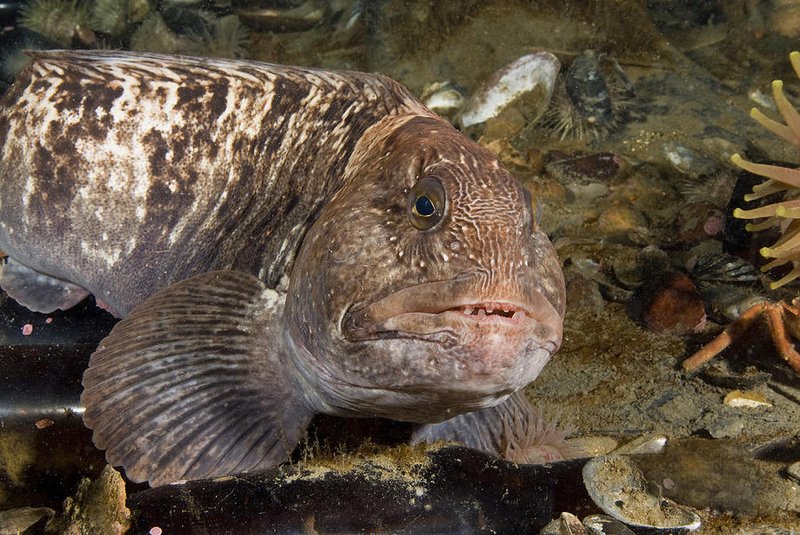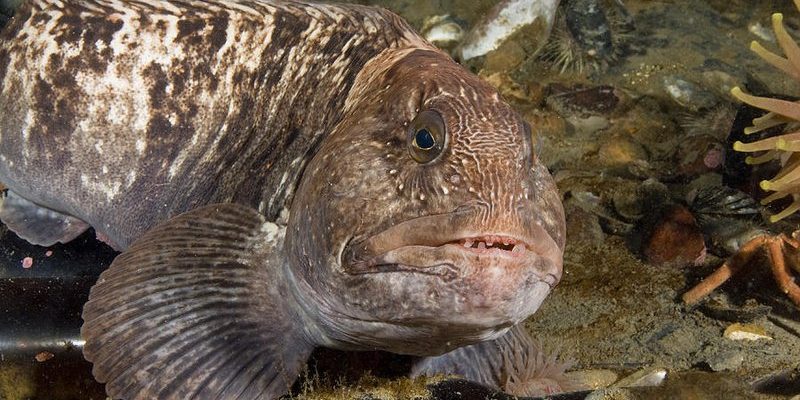
Have you ever heard of a wolffish? If not, you’re in for a treat. These fascinating creatures are not just your average fish; they boast a unique appearance and a striking personality that makes them stand out in the ocean. With their long, slender bodies and large, fang-like teeth, wolffish are often described as the wolves of the sea. Imagine encountering a deep-sea predator that looks like it came straight out of a storybook — that’s the wolffish for you.
Wolffish inhabit the cold depths of the North Atlantic Sea and are not only interesting for their looks but also for their role in the ecosystem. They help balance marine life in their habitat, making them crucial for the health of the oceanic food web. So, why are they called wolffish? Well, it’s all about those impressive teeth! Just like a wolf, these fish have a fierce bite that they use to tackle their prey.
Classification and Species
The wolffish belongs to the family Anarhichadidae and is known for its distinct characteristics. There are several species of wolffish, each with its own unique traits. The most recognized species include the Atlantic wolffish, the northern wolffish, and the spotted wolffish. Each of these species can be found in various parts of the North Atlantic, adapting to their environments with ease.
To give you a clearer picture, let’s break down the three main species:
- Atlantic Wolffish: This species is known for its large size, reaching up to 1.5 meters long. It’s easily identifiable thanks to its distinctive color pattern and large teeth.
- Northern Wolffish: A bit smaller, this fish usually grows up to 1.2 meters long. Its body is more elongated, and it’s often found in the rocky ocean bottoms.
- Spotted Wolffish: True to its name, this species has a unique spotted pattern and is generally smaller than the other two, normally maxing out around 1 meter in length.
Physical Characteristics
One of the first things you’ll notice about the wolffish is its striking appearance. Their bodies are long and eel-like, with a slightly flattened head. But what really sets them apart are their large, prominent teeth, which can grow up to several inches long. These teeth aren’t just for show; they help the wolffish capture and consume its prey, which typically includes crustaceans and other fish.
In terms of coloration, wolffish can range from a bluish-gray to brownish hues, often with patterns that help them blend into their rocky environments. This camouflage is crucial, as it allows them to stalk their prey without being easily spotted. The wolffish’s skin is also remarkably thick, providing protection against predators and harsh ocean conditions.
| Species | Size | Diet | Habitat |
| Atlantic Wolffish | Up to 1.5 meters | Crustaceans, fish | North Atlantic Ocean |
| Northern Wolffish | Up to 1.2 meters | Crustaceans, mollusks | North Atlantic Ocean |
| Spotted Wolffish | Up to 1 meter | Fish, crustaceans | North Atlantic Ocean |
Habitat and Distribution
Wolffish are predominantly found in the cold waters of the North Atlantic, from the coasts of Canada to the waters around Europe. They thrive in deep, rocky seabeds, often hiding in crevices and caves during the day. This behavior not only provides shelter from predators but also gives them an advantage when hunting.
The depth of their habitat can vary significantly; some wolffish prefer shallow waters, while others are found in depths reaching over 600 meters. The rocky terrain provides the perfect environment for them to blend in and stalk their prey. As such, these fish play a vital role in maintaining the ecological balance in these marine ecosystems.
Interestingly, climate change poses a threat to their habitats. As ocean temperatures rise, the distribution of wolffish may shift, impacting their survival. Conservation efforts are crucial to ensure that these unique creatures continue to thrive in their natural habitats.
Diet and Feeding Habits
You might be wondering what wolffish eat. These formidable fish are carnivorous, feeding primarily on crustaceans, mollusks, and smaller fish. Their impressive teeth are perfect for crushing hard shells, allowing them to dine on creatures that many other fish can’t tackle. Think of them as the strongmen of the ocean — if it’s on the menu, they can usually manage to get it down!
Wolffish often hunt at night, using their keen sense of smell to locate prey in the dark depths of the ocean. When they spot a meal, they use a unique hunting technique, launching themselves toward it with surprising speed. Their strong jaws grip onto their prey quickly, ensuring that they don’t lose their meal.
Another fascinating aspect of their feeding habits is their role in the ecosystem. By preying on crustaceans and other fish, wolffish help maintain a balance in the population of these species. This, in turn, supports the overall health of their marine environment. Without these predators, their ecosystems could become imbalanced, leading to overpopulation of certain species and depletion of others.
Reproduction and Life Cycle
The reproductive habits of the wolffish are intriguing. They typically spawn in the colder months, usually from late winter to early spring. Female wolffish produce large batches of eggs, often laying thousands at one time. These eggs are adhesive, allowing them to stick to rocky surfaces — a clever strategy to keep them safe from predators.
Once the eggs are laid, both male and female wolffish take on protective roles, guarding the nests until the eggs hatch. This parental care is somewhat unusual for fish, making wolffish stand out even more in the animal kingdom. After about 4 to 6 weeks, the eggs hatch into small larvae, which drift freely in the water, eventually settling into the ocean floor as they grow.
As the young wolffish mature, they begin to develop their characteristic features, such as those notorious fangs. They grow quickly, reaching maturity at about 3 to 4 years, depending on the species. Their lifespan in the wild can vary, but wolffish can live for over 20 years, so they have plenty of time to find their place in the ecosystem.
Threats and Conservation
Despite their impressive adaptations, wolffish face several threats. Overfishing is one of the most significant issues, as their populations have declined in many areas due to increased human activity. The demand for wolffish in both commercial fisheries and recreational fishing has led to concerns about their sustainability.
In addition to overfishing, habitat loss and climate change can jeopardize their future. As ocean temperatures continue to rise, the delicate balance of marine ecosystems is disrupted, which could affect the wolffish’s food sources and breeding grounds. Conservation efforts are essential to ensure that these unique fish are protected for future generations.
Organizations are working on various initiatives to raise awareness and create sustainable practices for fishing wolffish. Regulations are being put in place to limit catches and protect their habitats, which can help their populations recover. It’s a reminder that every creature, no matter how fierce, plays a crucial role in maintaining the health of our oceans.
Wolffish are more than just intriguing predators in the sea; they represent a vital part of the underwater ecosystem. Their unique physical characteristics, fascinating behaviors, and important roles in their habitats make them a subject of interest for both researchers and nature lovers alike. Understanding and appreciating these remarkable creatures is essential for their conservation. With continued efforts, we can help ensure that wolffish thrive in the oceans for years to come.
FAQ
What do wolffish taste like?
Wolffish are known for having a mild, slightly sweet flavor. Their texture is firm and flaky, making them a popular choice for seafood dishes. Many people enjoy cooking wolffish in various ways, including grilling, baking, or frying. If you haven’t tried it yet, you might find it a delightful addition to your dinner table!
Are wolffish dangerous to humans?
While wolffish may look intimidating with their large fangs, they are generally not dangerous to humans. They are unlikely to attack unless provoked. Most encounters with wolffish occur when they are caught by fishermen, and they may attempt to bite if they feel threatened. However, they are more focused on their natural prey than on bothering humans.
How can I help protect wolffish populations?
You can support the conservation of wolffish by promoting sustainable fishing practices and advocating for the protection of their habitats. Be mindful of where your seafood comes from, and choose sustainably sourced fish whenever possible. Additionally, supporting organizations that focus on marine conservation can make a difference in protecting these incredible creatures.
Do wolffish have any natural predators?
Yes, wolffish do have natural predators. Larger fish, sharks, and seabirds may prey on young wolffish. Additionally, marine mammals, such as seals, can pose a threat to them. However, adult wolffish are relatively safe due to their size and formidable teeth, which help deter potential attackers.
How long do wolffish live?
Wolffish can live for over 20 years in the wild. Their lifespan can vary based on factors like environmental conditions and the specific species. Atlantic wolffish tend to have a longer lifespan compared to their smaller relatives, so the health of their habitats plays an important role in their longevity.
Can wolffish be kept in aquariums?
While it is technically possible to keep wolffish in aquariums, they require a specialized environment, including plenty of space and appropriate water conditions. Their size and dietary needs can make them challenging pets for the average aquarium enthusiast. If you’re considering keeping a wolffish, it’s important to do thorough research and ensure you can meet their needs.
What role do wolffish play in their ecosystem?
Wolffish play a vital role in their marine ecosystems as predators. By controlling the populations of crustaceans and smaller fish, they help maintain a balanced environment. Their feeding habits contribute to the health of the ocean, showcasing the interconnectedness of marine life and the importance of each species.
Are there any conservation efforts specifically for wolffish?
Yes, various organizations and research institutions are dedicated to the conservation of wolffish. Efforts include monitoring populations, establishing fishing regulations, and promoting awareness about the importance of these fish in the marine ecosystem. By supporting these initiatives, you can help contribute to the protection of wolffish and their habitats.
What is the best way to cook wolffish?
Cooking wolffish is quite versatile. Many people enjoy pan-searing or grilling it, as the firm texture holds up well to different cooking methods. You can season it simply with herbs and lemon for a light meal, or incorporate it into hearty dishes like chowder. The mild flavor makes it an excellent canvas for various culinary creations!
How do researchers study wolffish?
Researchers study wolffish through various methods, including tagging and monitoring populations to track movement patterns, breeding habits, and response to environmental changes. They may also examine their diet and habitat use to better understand their role in marine ecosystems. This research is crucial for developing effective conservation strategies and ensuring the survival of these unique fish.

